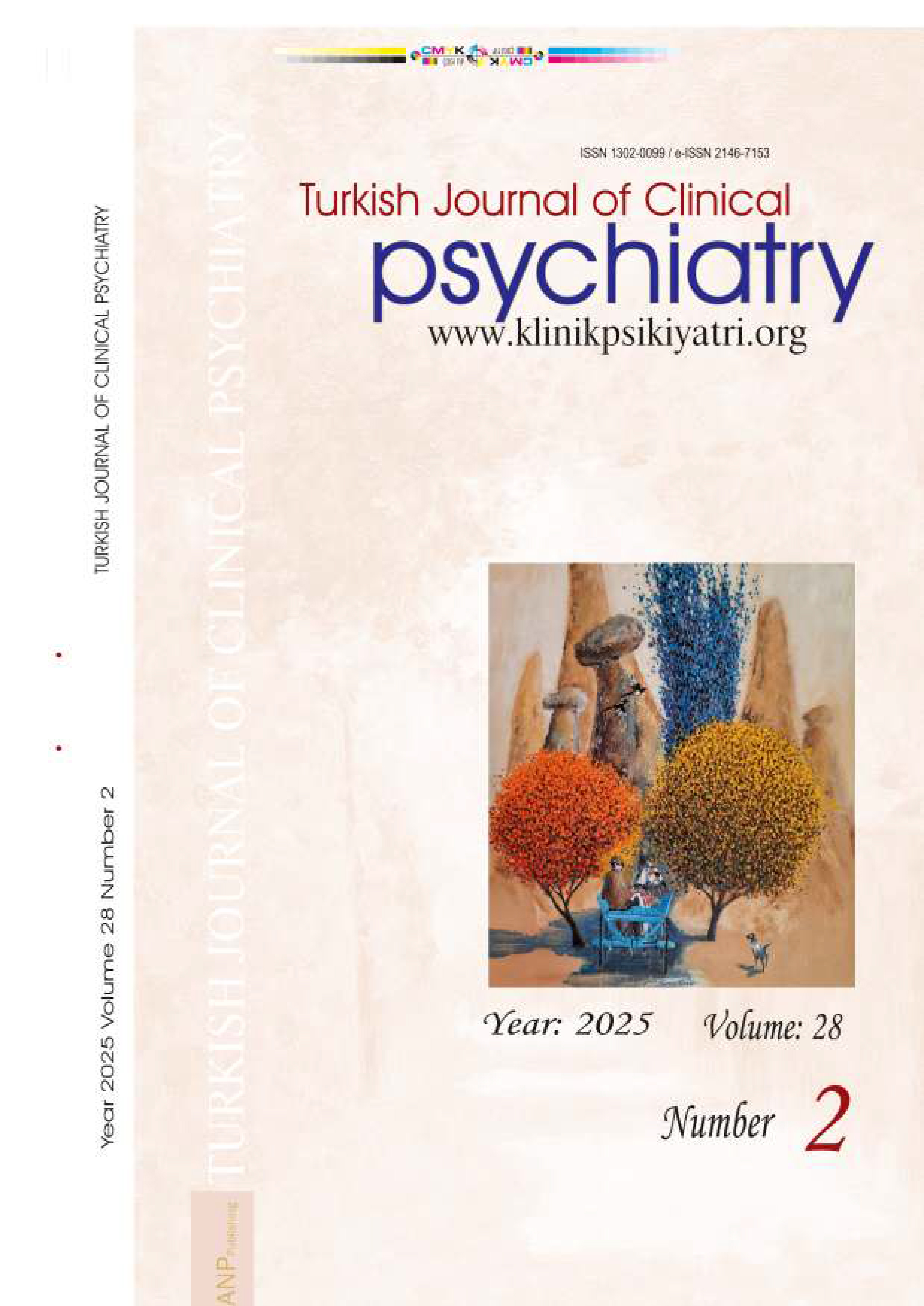





Volume: 7 Issue: 2 - 2004
| RESEARCH ARTICLE | |
| 1. | Hekimlerin Konversiyon Bozukluğuna Yaklaşımını Etkileyen Faktörler Uğur Bediz, Çiğdem Aydemir, Ayşe Devrim Başterzi, Cebrail Kısa, Sevsen Cebeci, Erol Göka Pages 73 - 79 Objectives: Conversion disorder is the dysfunction of body that occurs in the basis of stress and that does not conform the known pathways of anatomy and physiology of central or peripheral nervous system. Conversion disorder is the most frequently seen somatoform disorders. It is estimated in Turkey that conversion disorder constitutes the 25.1 % of the psychiatric consultations. However in primary health care psychiatric disorders particularly conversion disorder is hardly diagnosed. The aim of this study is to determine intervention patterns of physicians to conversion disorder and factors affecting to their interventions. Method: 102 physicians who are working in Ankara Numune Hospital's emergency room as general practitioners and rotating residents constituted the population of this study. 28 of whom had psychiatry rotation and 74 had not. Psychiatry residents were not involved in this study. All the subjects filled a questionnaire about their demographic variables and about conversion disorder. The subjects also filled Emphatic Skills Scale, Maslach Burnout Inventory, Work redesign and Toronto Alexithymia Scale. Results: The two groups were significantly different by means of intervention methods to conversion disorder, and their knowledge about this subject. The subjects did not differ by means of their emotional responses to conversion disorder and their scores on the scales except emphatic skills scale. Conclusion: The results of this study strongly indicate that the attitudes of physicians towards conversion disorder are affected from their knowledge rather than their emotional state. This finding emphasize that education of physicians about conversion disorder can enhance the quality of the care that patients get in hospitals |
| 2. | Plasma Zinc and Copper Levels in Boys with Attention Deficit Hyperactivity Disorder Özgür Yorbık, Abdullah Olgun, Pınar Kırmızıgül Pages 80 - 84 Objective: Attention deficit hyperactivity disorder (ADHD) is the common psychiatric disorder of inattention, hyperactivity, and impulsivity. Zinc and copper are essential trace elements having an important role in brain development and function. Limited studies have investigated these trace elements in ADHD. The aim of this study is to compare plasma zinc and copper levels between children with ADHD and normals. Method: ADHD diagnosis was made by using DSM-IV Based Disruptive Behavior Disorders Screening and Rating Scale (DBD-STS). Plasma zinc and copper levels have been measured in 26 boys with ADHD having a mean age of 9.3±1.9 years and in 24 healthy boys having a mean age of 8.3±2.1 years, with atomic absorbtion spectrophotometry method. About %54 of children with ADHD had comorbid oppositional defiant disorder. Results: Plasma zinc level in the ADHD children was found to be significantly lower than normals (p<.05). Decreased plasma copper level was found in the children with ADHD compared to controls (p<.05). Conclusion: These results in present study suggested that a subgroub of ADHD children is associated with decreased plasma copper levels. However, pathophysiological importance of this result remains unclear. There could be a sub-group with lower plasma zinc level in ADHD. Further studies is needed to confirm these results, and to illustrate reasons of zinc deficiency and the effects of zinc treatment in this sub-group of ADHD. If the importance of zinc in the ADHD has been shown, supplementation of this trace element in the treatment of ADHD could be available. |
| 3. | The Quality of Life in the Patients with Type II Diabetes Mellitus and Effects of Complications on the Quality of Life İbrahim Eren Pages 85 - 94 Objective: The quality of life has been accepted an important survival indicator of disease in the patients with Diabetes Mellitus. The aim of this study was to investigate the effects of complications on the quality of life and other factors involving quality of life in the patients with type II Diabetes Mellitus. Method: Fifty patients with complication and fifty four patients without complication, total 104 patients with type II Diabetes Mellitus were involved to the study from Endocrinology outpatient unit in Suleyman Demirel University Medical Faculty. All patients were assessed using of sociodemographic data form, WHOQOL-BREF (TR) scale, Hamilton Depression Rating Scale, Hamilton Anxiety Rating Scale. Results: It was found that WHOQOL-BREF (TR) scale physical health, psychological, social relationships, environment and environment (TR) domain and overall quality of life, general health, quality of life total scores were significantly low in patients with complication than without complication. In total patient group, social, environment (TR) domain, general health and quality of life total scores were found significantly more decreased in women than in men. It was determined that social, environment (TR) domain scores were significantly more decreased in patients with two different complications than in patients with one complication. It was determined that WHOQOL-BREF (TR) scale scores were inversely related to age, duration of diabetes, HbAlc and Hamilton Anxiety Rating Scale scores. Conclusions: Complications developed in diabetic patients have negative effects on the quality of life. Prevention and appropriate treatment of complications are important for improvement of quality of life in diabetic patients. |
| 4. | The Study of Alexithymia, Anxiety, Worry and Depression Levels of the Patients Who Suffered by Mastalgia and Underwent to Radiodiagnostic Assey Gökhan Aksu, Çiçek Hocaoğlu Pages 95 - 102 Objectives: The objective of this study was to investigate the psychopathology in patients attending radiological clinics with the complaint of mastalgia and to determine the levels of anxiety, depression, worry and alexithymia by comparing the results with those in controls. Method: Patients attending to the Department of Radiology, KTU Medical Faculty during a pre-defined time period with the complaint of mastalgia were included in the study.The study group consisted of 33 patients meeting the exclusion/inclusion criteria for the study; age and sex matched patients (n=33) seen in our outpatient clinic for routine medical examinations were used as controls. All patients included in the study completed sociodemographic data collection form, State Trait Anxiety Inventory, Revised Symptom Check-List, Hamilton Depression Rating Scale and Toronto Alexithymia Scale, and the results were compared between the two groups. Results: The two groups did not differ significantly with regard to sociodemographic characteristics. The levels of general psychopathology, anxiety, depression, and worry were high in patients for whom no organic etiology was detected to explain mastalgia. There were no differences between the patient group and control group with respect to alexithymia, and neither of the groups were alexithymic. Conclusion: The results of this study suggest the presence of psychopathology in patients with mastalgia for whom no organic cause could be detected, and indicates the need for psychiatric assessment in this patient population. |
| 5. | Symptoms and Diagnoses of First-Time Adolescent Applications to a Child and Adolescent Psychiatry Out-Patient Clinic Işık Görker, Ümran Korkmazlar, Melek Durukan, Arzu Aydoğdu Pages 103 - 110 Objectives: The aim of this study was to assess the psychological complaints of adolescents within a biopsy- chosocial transformation and growth period who have applied to a Child and Adolescent Psychiatry out-patient Clinic and the diagnostic criteria they have fullfilled. Methods: 1079 adolescents (638 boys, 441 girls) aged between 12-18 and who were seen in Istanbul University, Istanbul Medical Faculty, Department of Child Psychiatry between 2001 and 2002, were investigated retrospectively for symptoms and relevant diagnoses. Results: When complaints of all adolescents during referral were reevaluated 226 symptoms were recognised. Although the frequency and distribution of symptoms varied according to gender, the most common complaints were nervousness, school failiure, nail biting, anxiety, introversion, not getting along well with peers and sibling rivalry. When DSM-IV diagnostic criteria were used, 200 adolescents (18.54%) did not meet any diagnosis. 613 adolescents (56.81%) had an axis I disorder, 203 adolescents (18.81%) an axis II disorder, 63 adolescents (5.84%) an axis III disorder. 165 adolescents (1 5.29%) had comorbid diagnosis. Conclusion: Diagnoses of adolescents which mainly consisted of Axis I were evaluated and discussed. The group consisting of 18.53% which did not meet any of the DSM-IV diagnostic criteria made us think that evaluation of adolescents might not be confined to existing criteria |
| REVIEW | |
| 6. | Personality Disorder Comorbidity in Alcohol/Substance Use Disorders: A Review Cüneyt Evren Pages 111 - 119 Personality disorder comorbidity is common among patients with substance use disorder. This article reviews the prevalence of comorbid personality disorder in alcohol/substance use disorders, methodological problems while examining this topic, etiological models, the impact of personality disorder on course and outcome of substance use disorders and treatment of this comorbid conditions. The literature search was conducted through the Medline records of the National Library of Medicine Substance use disorder and personality disorder comorbidity is common in clinical practice, although this does not result with clear diagnosis of these patients or change in treatment approach. Most prevalent personality disorder cluster diagnosis is cluster B in substance use disorders. Among cluster B most prevalent diagnosis is antisocial and borderline personality disorders. Although patients with comorbid personality disorders benefit from treatment as much as those patients without comorbidity, personality comorbidity predicts relapse in these patients. Comorbidity of personality disorders also rises the risk of axis I disorder comorbidity. Having low "self directedness" score on Temperament and Character Inventory (TCI) is related with high personality disorder risk among patients with substance use disorders. Examining effects of personality on substance use disorders will help clarify individuals with high risk of substance use disorder and also will help to match the treatment seeking individual with different treatment approach. Studies to evaluate personality disorders in drug use disorders are needed in Turkey. Treatment approach must be different in patients with comorbid personality disorder. Treatment may not be successful if both disorders are not treated at the same time. |
| 7. | Therapeutic Sleep Deprivation in Depression Okan Çalıyurt, Funda Güdücü Pages 120 - 126 Total sleep deprivation for one whole night improves depressive symptomes in 40-60% of treatments. Sleep deprivation response shows up in the sleep deprivation night or on the following day. Some patients respond after recovery sleep only. But after recovery sleep most of the patients suffer a complete or partial relapse. On the other hand, improvement can last for weeks. Relapse after recovery sleep is less when patients are receiving medication. A number of studies have suggested that sleep deprivation followed by immediate treatment with an antidepressant sustains the antidepressant effect of sleep deprivation. Sleep deprivation leads to sleepiness, impairments in mood, cognitive and motor functions and also my precipitate mania in bipolar I patients. Other types of sleep deprivations includes REM sleep deprivation and partial sleep deprivation. Partial sleep deprivation in the second half of the night is equally effective as total sleep deprivation. The pathophysiology of sleep deprivation is not well understood; however, monoaminergic transmission is reportedly enhanced by sleep deprivation. The best predictor of a therapeutic effect is a large variability of mood. The main indication of sleep deprivation therapy is the depressive syndrome and sleep deprivation may prevent premenstrual mood swings, and could be use in partum and postpartum depression because of it's noninvasive nature. Finally there are considerable economic advantages of using sleep deprivation in major depression compared to drug therapy. Sleep deprivation therapy with fast acting antidepressive effects could be use an augmentation agent as an alternative antidepressive therapy with pharmacothearpy. |
| CASE REPORT | |
| 8. | A Case with Trichotillomania, Psychogenic Excoriation and Pathological Internet Use Birgül Elbozan Cumurcu, Burhanettin Kaya Pages 127 - 131 At present time related with their widespread use, excessive use of computer and internet has become an important problem. While there is still controversy about whether internet addiction is real or not, it has been successfully aggreed that since the behavior exists, it must be recognized and treated accordingly. Internet dependence can be observed even in people without any dependence problem or psychiatric disorder and may disturb social and occupational functionality. Pathological internet use may be a subject of controversy in two different DSM-IV diagnostic classifications. Although initial reports mostly associate pathological internet use with substance abuse or dependence, recent findings give an idea that this disorder probably related to impulse control disorder not otherwise specified. Pathological internet use can be classificated either substance related disorders or pathological gambling which is included in not otherwise specified impulse control disorders. Presence of cases accompanied with both alcohol or substance dependence and multiple impulse control disorders suggest that controversies related with classification will be further continued. Over the past several years, clinicians have reported cases of internet addiction. In our study, was a case with pathological internet use, trichotillomania and psychogenic excoriation was found to be interesting and discussed in the light of the literature |










